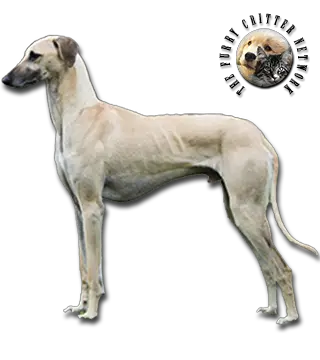Breed Standard
Head: Long, elegant, slender, but fairly large. Skull flat, fairly broad, rounded at the back. Very slightly pronounced stop. Straight nosebridge. Muzzle shaped like an elongated wedge. Strong jaws. Thin, supple lips.
Ears: Set on high, pendulous, lying very flat against the head, not too large, triangular, slightly rounded at the tip.
Eyes: Large. Eyelids slightly slanted. Dark or amber if the coat is light-colored.
Body: Square build. Neck long, without dewlap. Chest deep, not too broad. Flat ribs. Pronounced tuck-up. Bony, slanting croup. Short, nearly level back.
Tail: Thin, bony, carried above the topline.
Hair: Very close-lying, dense, fine.
Coat: Sand. Light sand with or without black mask. Chestnut-sand with or without black mantle. Smoky sand. Brindle.
Size: Dog: 66 to 72 cm (26-28,5 in).Bitch: 61 to 68 cm (24-27 in).
Weight: 30 to 32 kg (66-70,5 lb).
History
The Arabian Sighthound's origin is mostly a matter of speculation. It is thought that Arabian Sighthounds originally came from the Orient or from what is today Ethiopia (the tributes to the Pharaohs included smooth Lop-eared Sighthounds from Nubia, south of Egypt). The Arabian Sighthound is one of the two African Sighthound breeds recognized by the FCI. On old fragments of earthenware (about 3000 B.C.), a short-haired sighthound with lop ears was discovered that looks like a Arabian Sighthound. Today, the Arabian Sighthound is found mainly in Morocco, Algeria, Tunisia, Libya, and Morocco is responsible for the breed's FCI Standard. It is not to be confused with the smooth Saluki of the Arabian peninsula and the Middle East, which is a variety of the Saluki breed. It is also not to be confused with the smooth Afghan Hound, which is a variety of the Afghan Hound. The Arabian Sighthound was and is still used for hunting in its native countries, and is also a reliable guarding dog.
Behavior
The Arabian Sighthound is a primitive hunting breed that bonds extremely closely with its owner or family from an early age. They are unlikely to be exceedingly shy or aggressive. A well bred and well socialized Arabian Sighthound is a stable, attentive, and exceedingly loving family member.
The American Arabian Sighthound Association standard states that, “The Arabian Sighthound is a dog with class and grace. The attitude is noble and somewhat aloof.”
Because of their origins as the hunters and guardians of Sahara nomads and bedouins, the Arabian Sighthound is reserved with strangers and takes a while to warm up to new friends. The Arabian Sighthound also expects reserve from people they meet, and may not appreciate those who are too familiar. The Arabian Sighthound is also noted for its primitive instincts, for unlike other sighthound breeds it is highly alert and territorial which made them prized by the Berbers, not only as hunters, but as fearless watch dogs.
Improperly socialized Arabian Sighthounds can be shy and or aggressive towards other dogs, and it is critical that breeders consider temperament in their breeding decisions and that puppies receive appropriate socialization from an early age so that they mature into well adjusted adults. Their socialization must include not only new people, but new situations, environments and other dogs.
Arabian Sighthounds that are accustomed to children and are excellent with them. As with all breeds, children need to be taught to respect dogs and not to mistreat them.
They require ample daily exercise in order to meet their physical, emotional and mental needs. This is not a breed that is well suited to apartment life without a planned regimen of daily exercise that includes galloping freely.
Arabian Sighthounds have been bred for millennia to course game and as a result have extremely high prey drive. They can be wonderful with cats, small dogs and other animals if they are introduced at an early age and learn that these other pets are not prey.
The Arabian Sighthound's character is also tender and intelligent and they are sensitive to correction. They must be trained with methods that are also intelligent and sensitive. Heavy-handed or corporal training methods are not effective for any breed, but they are especially deleterious to the character of sighthounds.
Function
The Arabian Sighthound was used along with falcons to hunt wild game. Some game that was hunted by this breed include gazelles, jackals, desert hare, and foxes. This breed is also used as a guard dog. It will protect its owner’s livestock and home. Over time, the Arabian Sighthound has adapted to the desert life in northwestern Africa, including the Maghreb area.
Health
Only a few genetic conditions have been confirmed in the breed. These include certain autoimmune disorders, such as Addison's disease and irritable bowel syndrome and progressive retinal atrophy. The Arabian Sighthound is one of the breeds for whom a genetic test for progressive retinal atrophy has been developed to with a simple blood test. Like all sighthounds, the Arabian Sighthound is very sensitive to anesthesia, and can be sensitive to vaccines, worming, and other medications, so these routine treatments should be spaced apart instead of given all at once. The breed tends to enjoy excellent health into old age.






